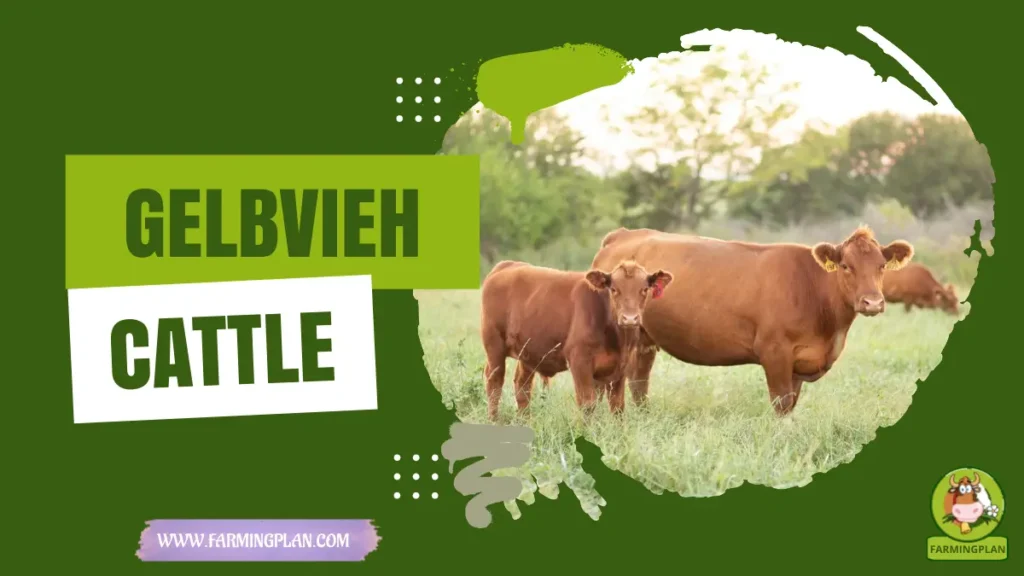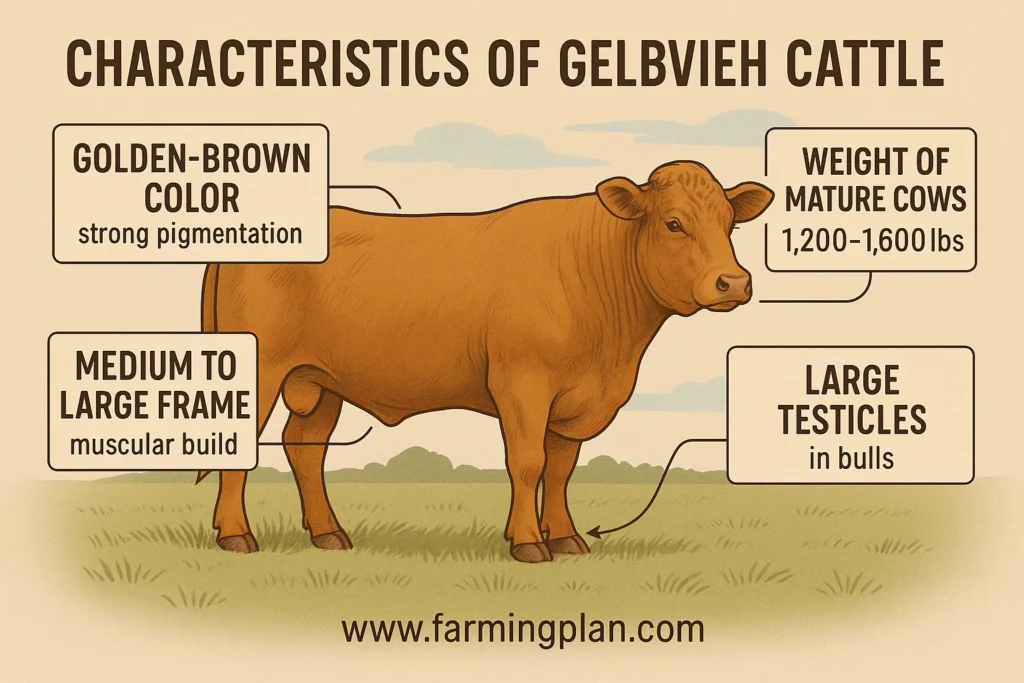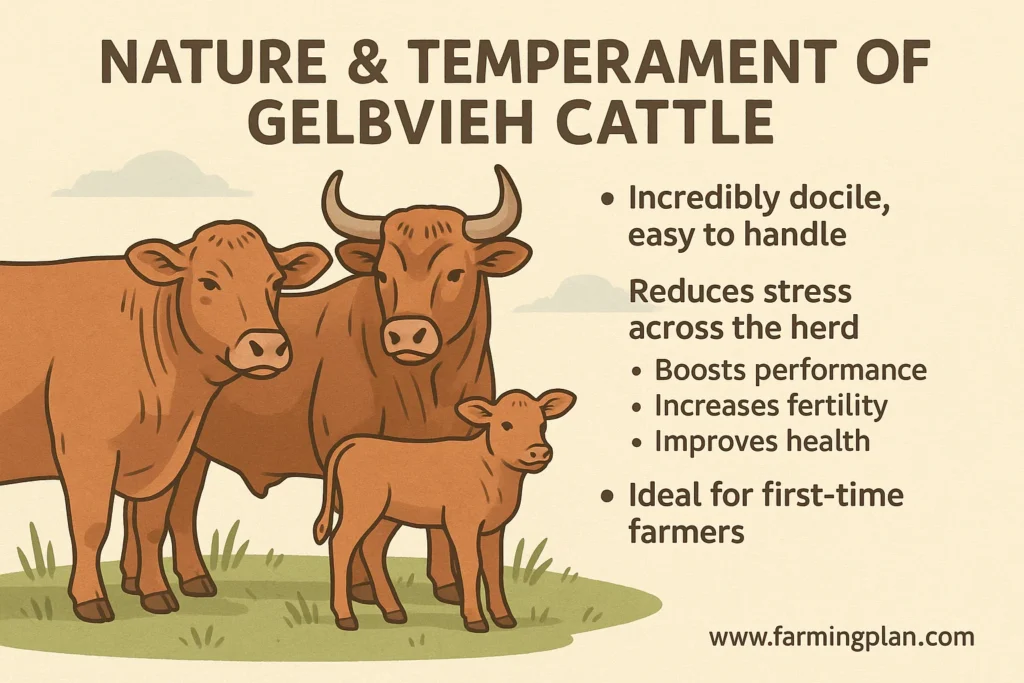When it comes to raising beef cattle, I’ve learned one golden rule—trust the genetics that work. That’s why I’ve leaned heavily into raising Gelbvieh Cattle over the years. These golden-brown beauties, originally from Germany, aren’t just another breed on the pasture—they’re beef-making machines with maternal power, growth traits, and calm temperaments that make your life easier. Whether you’re a first-time cattle producer or have been running herds for decades, Gelbvieh and their Balancer hybrids have something special to offer. In this article, I’ll walk you through everything I know from years in the field—breeding, feeding, health tips, even how to find Gelbvieh bulls for sale. Let’s dig in!

History & Origin of Gelbvieh Cattle
The Gelbvieh breed originated in Bavaria, Germany, over 150 years ago. The name “Gelbvieh” literally means “yellow cattle,” thanks to their distinct golden-brown coat. Originally developed as a triple-purpose breed for milk, meat, and draft work, Gelbvieh gained popularity for their impressive growth and fertility traits.

By the early 1970s, the breed made its way to North America, with the American Gelbvieh Association officially forming in 1971. U.S. breeders embraced the Gelbvieh’s fast growth, lean carcasses, and maternal superiority. Over time, crossbreeding with Angus created the now-popular Balancer breed—a hybrid known for its beef quality, feedlot performance, and hybrid vigor. The Balancer breed is a mix of Gelbvieh and Angus, inheriting the best traits of both breeds.
Read More: Fleckvieh Cattle: The Spotted German Breed
Characteristics of Gelbvieh Cattle
Gelbvieh cattle, with their medium to large-framed bodies and muscular builds, are adaptable to various climates. Their distinct golden-brown color, which varies slightly between animals, is a result of their strong skin pigmentation that helps protect them from sunburn—a bonus in warmer climates. This adaptability is a testament to their hardiness and suitability for different farming conditions.

Physically, Gelbvieh bulls often weigh 2,000–2,400 lbs, while mature cows weigh between 1,200–1,600 lbs. Calves are born with moderate birth weights but show superior growth, with weaning weights often well above average. One standout trait? Testicular development in bulls. Gelbvieh bulls are known for having the largest testicles among beef breeds, which correlates with fertility and earlier maturity in their heifer progeny.
Read More: Angus Cattle: A Scottish Breed of Cattle
Nature & Temperament of Gelbvieh Cattle
What really sold me on Gelbvieh wasn’t just their performance—it was their calm, manageable nature. Gelbvieh cows and bulls are incredibly docile, making handling much safer and easier, especially for smaller farms or family operations. Their quiet temperament reduces stress across the herd, which actually boosts performance, fertility, and health. Their calm behavior makes them ideal for first-time farmers or those working in close quarters, instilling confidence in your ability to manage them effectively.

I’ve found their quiet temperament reduces stress across the herd, which actually boosts performance, fertility, and health. Their calm behavior makes them ideal for first-time farmers or those working in close quarters. Even their calves tend to be curious but composed. If you’re tired of dealing with high-strung breeds, you’ll appreciate how relaxed these animals are.
Read More: Charolais Cattle: A French Breed
Food & Diet
Feeding Gelbvieh cattle isn’t complicated, but they do have high growth potential—so they benefit from a nutrient-rich diet. I stick to a combination of high-quality pasture, dry hay, corn silage, and grain supplements for those in heavier production phases.
Here’s what I recommend:
- For breeding cows: Maintain body condition with protein-rich forages and minerals.
- For calves: Creep feeding helps boost weaning weights.
- For bulls: Add protein and energy-rich grain for development.
Always keep clean water and mineral supplements available. Avoid sudden diet changes, and never skimp on nutrition during gestation or weaning periods—this is when the foundation for growth is laid.
Usage & Purpose
While Gelbvieh started as a triple-purpose breed, today they’re mainly raised for beef. And let me tell you—they do it well. Whether you’re a commercial cattleman looking to boost weaning weights or a seedstock producer, these cattle deliver. Their top uses include commercial beef production, replacement heifers with maternal strength, crossbreeding (especially Balancer cattle programs), feedlot performance bulls, and carcass trait improvement (lean meat + marbling). This significant role in beef production is something to be proud of.
Their top uses include:
- Commercial beef production
- Replacement heifers with maternal strength
- Crossbreeding (especially Balancer cattle programs)
- Feedlot performance bulls
- Carcass trait improvement (lean meat + marbling)
Gelbvieh Cattle are also used as terminal sires and perform exceptionally in pasture-to-plate programs. I’ve sold bulls to both large-scale ranchers and small hobby farms with excellent results. Their calm nature and manageable size make them a great fit for smaller operations, while their fast growth and high weaning weights make them a profitable choice for larger operations.
Special Features
If you’re looking for special traits, Gelbvieh bring a lot to the table. Here are a few reasons I keep them as the backbone of my herd:
- Fast Growth Rate – They add pounds quickly, boosting pounds of calf weaned per cow exposed.
- Maternal Superiority – Excellent milk production, fertility, and early puberty.
- Carcass Quality – Lean meat with solid marbling and yield grade.
- Large Testicular Size – Greater fertility and better heifer offspring.
- Strong Calving Ease – Especially in Balancer cattle crosses.
- Hardy & Heat Tolerant – Withstand extreme temps thanks to pigmentation.
- Hybrid Vigor – Perfect for composite breeding programs.
Big Growth Starts With Smart Breeding—Gelbvieh Cattle Bring Power, Calm, And Performance To Your Pasture.
Health Issues & Prevention
Like any breed, Gelbvieh cattle can face common beef cattle health challenges. But I’ve found them to be relatively hardy, especially when managed right.
Common Issues:
- Bloat (if grazing lush legumes)
- Respiratory infections in young calves
- Parasites (internal and external)
- Hoof issues in wet or rocky conditions
Prevention Tips:
- Deworm regularly
- Vaccinate for clostridial and respiratory diseases
- Provide shade and clean bedding in hot seasons
- Keep a close eye during calving for early interventions
Step-By-Step Farming Guide for Raising Gelbvieh Cattle
Step 1: Set Up A Proper Pasture & Shelter
Before bringing home any Gelbvieh cattle, make sure you’ve got the land ready. They need well-drained pasture with plenty of grass and shade. Rotate pastures to avoid overgrazing. Fencing should be sturdy—Gelbvieh are calm, but they’re big animals. Shelter should provide windbreaks in winter and shade in summer. I recommend simple metal barns or run-in sheds with straw bedding.
Step 2: Choose High-Quality Breeding Stock
Start with cows and bulls from reputable breeders or the American Gelbvieh Association listings. Look for bulls with strong EPDs (Expected Progeny Differences) in calving ease, weaning weight, and marbling quality. Balancer bulls are great if you want hybrid vigor in your herd. Always ask for performance records and calving history.
Step 3: Manage Breeding Season
I keep a tight breeding season—60 to 90 days. It simplifies calving and improves uniformity. Use visual heat detection or a timed AI program. Always observe calving closely and document everything.
Tip: Gelbvieh heifers reach puberty early, so plan to breed them at 13–15 months of age.
Step 4: Calving, Weaning, And Growth Monitoring
Gelbvieh cattle is usually smooth with Gelbvieh cows. After birth, ensure calves nurse quickly. I tag and weigh calves within the first 24 hours and monitor for respiratory issues. Weaning happens around 6 to 7 months. I transition calves slowly onto creep feed before full weaning to reduce stress.
Step 5: Market Your Cattle Smartly
You can sell Gelbvieh bulls, heifers, or calves through private treaty, local livestock auctions, or events like the Heart of America Gelbvieh Sale. Buyers look for performance data, so track everything. Keep your animals clean, healthy, and well-fed. The better they look, the more they’ll fetch.
Expert Tips & Best Practices
- Always record performance data—weight, health, breeding, etc.
- Work closely with your vet and nutritionist.
- Use AI to introduce top-tier genetics.
- Join your local Gelbvieh breeder association.
- Visit the American Gelbvieh Association website for EPD updates.
- Focus on calving ease if selling heifers to commercial producers.
- Rotate pasture and monitor manure for parasite load.
FAQ
What are Gelbvieh cattle known for?
Gelbvieh cattle are known for their fast growth, excellent maternal traits, and docile temperament. They also produce lean beef with high carcass yield.
What is the difference between Gelbvieh and Balancer cattle?
Balancer cattle are a hybrid of Gelbvieh and Angus. They combine the growth and fertility of Gelbvieh with the carcass and marbling traits of Angus.
Are Gelbvieh cattle good for beginners?
Yes, their calm nature and strong maternal instincts make them great for beginners, small farms, and family operations.
What’s the average weight of a Gelbvieh bull or cow?
Mature Gelbvieh bulls weigh between 2,000–2,400 lbs, and cows average 1,200–1,600 lbs.
Where can I buy Gelbvieh bulls or cows?
Check the American Gelbvieh Association listings, local breeder networks, or livestock expos like NEMO Farm Show or Ozark Farm Fest.
Conclusion
Whether you’re just getting started or looking to upgrade your beef program, Gelbvieh Cattle bring something special to the herd. From their superior growth rates to unmatched maternal ability, they deliver where it matters most—on performance, temperament, and market value. I’ve built a lot of my ranch’s success around these cattle, and I wouldn’t trade ’em for anything. If you’re ready to raise cattle that grow fast, calve easy, and stay calm, it’s time to give Gelbvieh a serious look.

